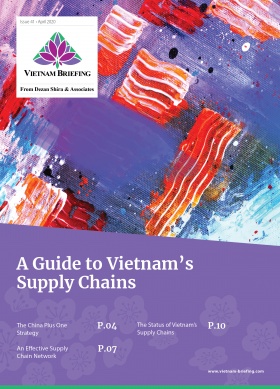Investment Opportunities in Vietnam’s Garment and Textile Industry
Vietnam’s garment and textile industry has been a cornerstone of the country’s rapid economic development. Despite global challenges, the sector has proven somewhat resilient and still presents a wealth of opportunities for foreign firms.
The garment and textile industry is one of the key industries in Vietnam. In 2022, the industry’s export value topped US$36.9 billion. The country’s exports has already reached US$24.6 billion in the first nine months (Jan-Sept) this year, according to the General Department of Customs.
These huge export numbers have been driven by a number of factors, including low labor costs and free trade agreements (FTAs) with key export markets that have in many cases eliminated tariffs on garments and textiles altogether.
Notably, however, there has been a marked decline in production on the back of lower demand in key export markets this year. S&P’s Purchasing Manager’s Index has consistently found itself below the 50-point mark indicating production in Vietnam is in a contraction. Furthermore, there have been layoffs around the country in the apparel sector on the back of lower-than-expected orders. Taiwanese footwear manufacturer Pou Yuen, for example, has reduced its workforce by almost 10,000 workers across three rounds of job cuts.
This downturn, however, may be only temporary as signs of a recovery are starting to take shape. Vietnam’s GDP growth, for example, has increased all three quarters of this year, and as the economy recovers, the garment and textiles industry should too.
With this in mind, here’s what Vietnam’s garment and textile sector looks like at the back end of 2023.
Garment and textiles in Vietnam: Overview
Vietnam’s garment and textile industry consists of 3 sub-sectors: the upstream sector (fiber production), the midstream sector (fabric production and dyeing), and the downstream sector (garment manufacturing).
Sub-sectors that produce fibers or fabric are mainly used for domestic consumption because they are often of a lower quality. The downstream sector of garment manufacturing accounts for the bulk of the apparel and textile sector in Vietnam with cut-make-trim (CMT) models being their main activities. CMT accounts for about 70 percent of the output of domestic garment and manufacturing firms, while the more advanced business models, like original equipment manufacturing (OEM) and original design manufacturing (ODM) account for around 30 percent.
The US, Europe, Japan, and South Korea are the main export destinations of Vietnam’s textile and garment products.
Top 10 export markets for Vietnam’s garments and textiles, 2022
| Country | Value $US |
| United States of America | 17,359,654,958 |
| Japan | 4,072,768,217 |
| Korea (Republic) | 3,309,446,324 |
| Canada | 1,311,234,139 |
| China | 1,200,981,253 |
| Germany | 1,067,313,569 |
| Netherlands | 1,032,197,613 |
| Cambodia | 876,337,017 |
| United Kingdom | 803,990,213 |
| France | 658,049,227 |
Although Vietnam has a huge potential for cotton cultivation and production, the textile industry imports most of the cotton inputs. In 2022, Vietnam imported US$3.76 billion worth of cotton. This came mostly from the USA, Australia, Brazil, India, and Argentina.
See also: Why Vietnam is Now the Biggest Importer of Australian Cotton
Growth factors
Increased market access through FTAs and technology are major growth drivers for the garment and textile industry. Vietnam’s bilateral and multilateral FTAs continue to provide Vietnamese manufacturers access to new markets. With new FTAs in effect, such as the Comprehensive and Progressive Agreement for Trans-Pacific Partnership (CPTPP) and Vietnam-EU FTA (EVFTA), Vietnam should see increased exports and a push to further develop the industry’s supply chain so that they can take full advantage of preferential tariffs.
Further, manufacturing shifts from China to Vietnam due to the labor cost advantage and rocky trade relations between China and the USA should also help expand Vietnam’s textile and garment industry.
That said, moving forward, market access alone will not be enough to generate growth. Vietnamese manufacturers will also need to invest in technology to increase productivity and quality in order to remain competitive.
Vietnam’s garment and textile manufacturing hub
Whereas northern Vietnam is most known for electronics manufacturing, southern Vietnam, is considered the garment and textiles hub of Vietnam. Ho Chi Minh City and the surrounding provinces of Dong Nai and Binh Duong are home to a large number of garment factories servicing a broad range of international brands. There are a number of reasons for this, but infrastructure and workforce are two of the most prominent.
Infrastructure in southern Vietnam
Ho Chi Minh City is home to Vietnam’s biggest port. As of 2019, the Port of Saigon was the 26th biggest container port in the world and the fifth biggest in the ASEAN region after the Port of Singapore, Malaysia’s Port Klang and Tanjung Pelepas, and Thailand’s Laem Chabang.
As a result, ports in HCMC are responsible for around 67 percent of Vietnam’s seaport throughput.
Around 80 km to the south of HCMC there is also the Cai Mep-Thi Vai Port. The Cai Mep-Thi Vai Port is a deep-water port, which allows for bigger ships to transport goods into and out of Vietnam. This can significantly reduce shipping costs for manufacturers. It is also connected by a multi-lane highway to Dong Nai and Binh Duong.
See also: Port Infrastructure in Vietnam 3 Regional Hubs for Importers and Exporters
Labor in southern Vietnam
Southern Vietnam has been a textile and garment hub for decades and now boasts a relatively high-skilled workforce in garment manufacturing. This low-cost labor can produce high value when managed and utilized correctly.
Ho Chi Minh City, Vietnam’s biggest city, is also located in the south. This is Vietnam’s biggest population center and has the full gamut of amenities of any big city in the world. Workers from Ho Chi Minh City can have a high quality of life within its borders while also commuting to factories outside of the metropolis in the surrounding provinces—it’s common for many companies to bus their employees into and out of the city.
Foreign brands manufacturing in Vietnam
There are hundreds of international brands manufacturing in garments and textiles in Vietnam but two of the most well-known are Adidas and Nike.
Adidas
In 2021, roughly 40 percent of Adidas footwear was produced in Vietnam. This follows a big shift over the past decade, with Adidas moving more of its supply chain out of China and south to Vietnam.
This is part of a broader trend in the garment and apparel manufacturing sector as wages in China rise and companies look for new low-wage workforces to produce their goods.
Not only that, but trade tensions between China and key export markets like the US, and supply chain disruptions as a result of COVID-19 border restrictions, have also provided impetus for sportswear companies to diversify their supply chains.
See also: Where Adidas’ Factories are Located in Vietnam
Nike
As one of the biggest, most well-known brands in the world, Nike is well and truly embedded in the fabric of international sports. This, however, would not be possible without the huge manufacturing operations Nike has developed in Southeast Asia. In particular, Vietnam has become an essential component of Nike’s supply lines.
In fact, 51 percent of Nike’s footwear in 2021 was produced in the Southeast Asian manufacturing powerhouse alone.
And this number is increasing—in 2021 Nike had just 138 suppliers in Vietnam. By November of 2022, however, that number had increased to 155.
See also: Where Nike’s Factories are Located in Vietnam
Government support policies
The government has centered its support for the textile industry by expanding industrial parks for textiles and stimulating domestic supporting industries. Local governments are being encouraged to assist firms in research and development activities, technology transfer, and innovation.
Corporate income tax (CIT) incentives
Corporate income tax (CIT) incentives are one of the most attractive features of the Vietnamese business landscape and tend to be one of the most important investment incentives to foreign investors.
There are two main CIT incentives in Vietnam: preferential tax rates, which are reduced tax rates, and tax holidays, which are essentially tax exemptions. These tend to vary based on the location, industry, investment zone, and a number of other factors.
Preferential tax rates
The different preferential rates include:
- 10 percent for the lifetime of the entire project;
- 10 percent for 15 years from the first year of income generation;
- 17 percent for the lifetime of the entire project; and
- 17 percent for 10 years from the first year of income generation.
Tax holiday rates
Tax exemptions include:
- Tax exemption for 4 years, 50 percent reduction of payable tax amounts for 9 subsequent years;
- Tax exemption for 4 years, 50 percent reduction of payable tax amounts for 5 subsequent years; and
- Tax exemption for 2 years, 50 percent reduction of payable tax amount for 4 subsequent years.
Looking ahead
Although the garment and textile industry has struggled this year, it is still strong and holds significant opportunities for foreign firms looking for a low-cost manufacturing base in Asia.
For its part, Vietnam intends to focus on moving up the value chain and building a national brand image that is competitive and quality driven. With these goals in mind and a proven track record of foreign firms making garments and textiles in this burgeoning Southeast Asian nation, Vietnam’s garment and textile sector is well poised to return to its upward trajectory as a global clothing manufacturing powerhouse in the very near future.
Note: This article was first published in May 2018. It was last updated October 27, 2023.
About Us
Vietnam Briefing is produced by Dezan Shira & Associates. The firm assists foreign investors throughout Asia from offices across the world, including in Hanoi and Ho Chi Minh City. Readers may write to vietnam@dezshira.com for more support on doing business in Vietnam.
- Previous Article Supermarket Chains in Vietnam: Opportunities and Challenges
- Next Article Case Study: Pandora and Vietnam’s Jewelry Market








